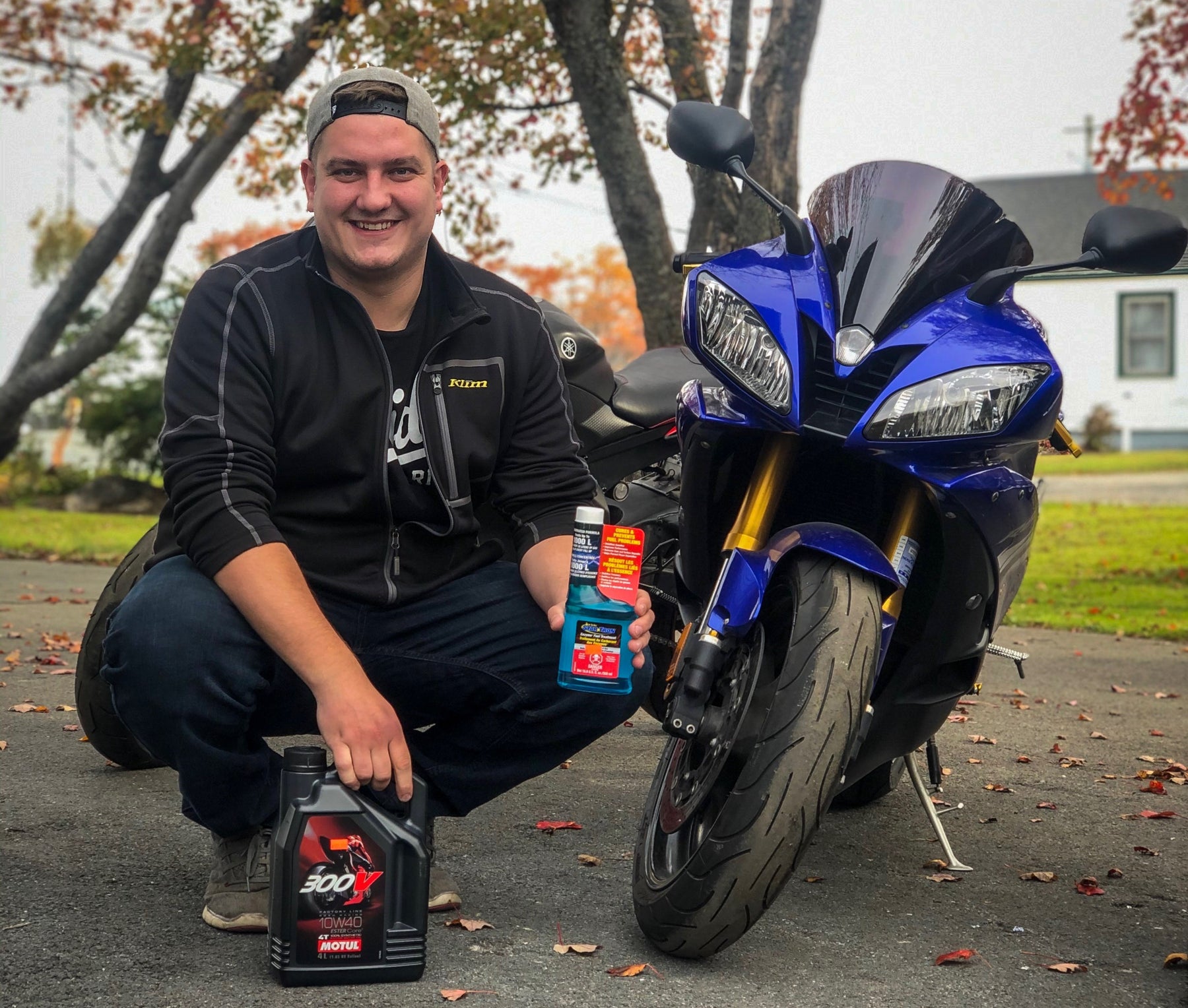Simply select "affirm" at checkout.

Motorcycle Winter Storage: Best Practices for a Trouble-Free Spring by Fun Expert, Brett Vanderkooi
Fall has begun! The leaves are changing and the days are getting shorter – sure signs that Moto Season is soon coming to an end. Eventually, the arrival of cold weather and snow will bring riding to a screeching halt, leaving us all impatiently waiting for spring. For most, this means that your two-wheeler will be in hibernation for serval months. To help make the transition smoother, we have a few winter storage tips for a trouble-free spring, ensuring you miles of smiles!

Prep and Body:
Storing your motorcycle for an extended period of time is not as simple as throwing a cover on your bike and waiting for the snow to melt. The procedure takes a little time and planning to save you money in the long run, and to keep your machine in perfect running order. One step that is often overlooked is to give the bike a good wash and wax. The reason this is important is to get the last of the season’s road grime and bugs washed off. This will keep the bike looking its best and make it much easier to clean next spring. Washing the bike is also a great way to inspect it for broken or warn components that may need to be addressed before the next riding season.
While washing your bike, be sure not to neglect the chain. Clean the chain with a good chain cleaner that is safe for O-rings, scrub with a steel or hard bristle brush, and rinse. Once your bike is clean and dry, re-lubricate your chain to keep it from rusting during storage. It is also a great idea to take some WD-40 or general purpose lubricant to lubricate any moving parts such as leavers and cables to keep them from becoming stiff or seized over winter. The same can also be done for any bare steel surfaces and components that could be prone to rust and oxidation.
Oil:
An oil and filter change before storage is highly recommended for your motorcycle. Immediately before changing your oil and filter, take the bike for a short ride, running through all the gears to stir up any dirt and debris. Dirt and debris in the oil is caused by leftover carbon and wearing parts during combustion. Leaving the old oil in the bike for an extended period of time will cause any of the unwanted debris that is suspended in the oil to settle in the bottom of your motor. This is something we want to avoid, and the easiest way to do so is with new oil and a new filter.
Fuel:
Fuel stabilization is an easy step that, when overlooked, can cause the bike to not start or not run correctly in the spring. It is especially important for carbureted machines, as the fuel in the carb can evaporate and leave residue, blocking jets and fuel passageways. Carburetor cleaning can be time consuming and costly depending on the make and model of the machine. Fuel purchased from your local service station has a shelf life of approximately 30 days before it starts to break down. Ideally, before storing your machine, fill the tank with premium fuel (longer shelf life) and add fuel stabilizer. If this step is done at home using a fuel jug, be sure to start the engine and let the machine run long enough to get the stabilizer through the entire fuel system.
Battery:
Motorcycle batteries must be stored correctly during winterization or there is a high probability that you will be replacing it every 1-2 seasons. One of the biggest mistakes when storing a battery is leaving a trickle charger on the battery continuously for the entire storage period. This can be as bad as, or worse than, leaving the battery in the bike untouched for several months. The exception to this would be leaving the battery on a “Smart charger,” which will not overcharge the battery. Ideal conditions for battery storage would be to remove it from the bike and place it in a warm and dry area with a trickle charge 1-2 times a month, or connect it to a smart charger.
Tires and Suspension:
Once you have your bike ready for storage it is time to tuck the bike into your garage, basement or shed. The best possible scenario would be to have the bike off the ground on front and rear stands. The benefit of having the bike on stands and not sitting on the ground is that if your tires leak down or go flat during the winter, they will not develop flat spots from sitting for several months. Another benefit to having the bike on stands is that the suspension will be fully extended, keeping some of the pressure off your seals while the bike is not in use. If stands are not an option, check your air pressure before storage and continue to monitor the pressure over winter.
Conclusion:
Winterization is probably one of the least appealing chores related to moto, but a little bit of time and preparation before storage can save you more time and money come spring. We all know that on the first warm days of spring you want to get out and blow the dust off. Don’t let a little laziness hold you back from getting back on the road. We know not everyone has a climate-controlled garage with ideal storage conditions, but with some of these storage tips you can make whatever you have work.
Written by HFX Motorsports Fun Expert, Brett Vanderkooi
















Leave a comment